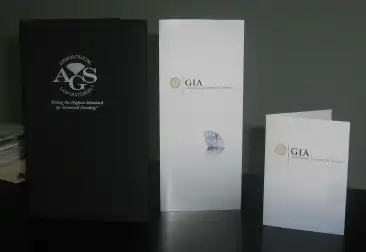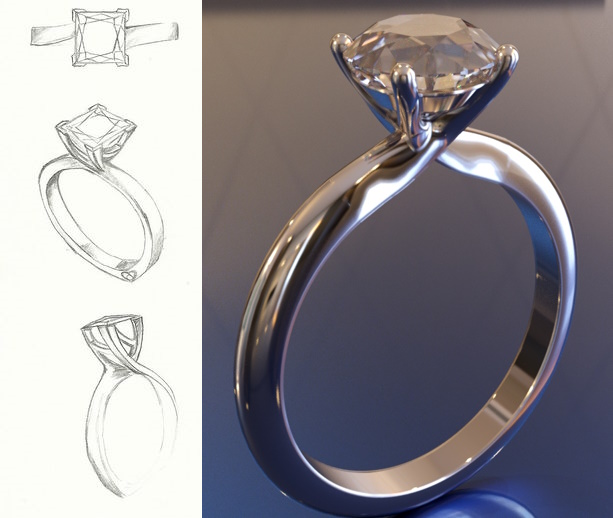25 years ago, in 1998, Jogia Diamonds was incorporated. Since then, our company has gone through a lot of changes. However, looking back on the past 25 years, the diamond and jewellery industry has changed even more. Most of these changes have been positive for both the industry and consumers and have affected everything from the way jewellery is sold to how it is designed and manufactured. As always, with certain parts of the industry being very resistant to change, some wholesalers and retailers still hold back and do things the “old fashioned” way, causing the division within the industry.
The Internet
When: Late 1990s
Back before the internet became popular, pretty much the only way to buy jewellery was to go to a local jeweller. The problem with that was that it was difficult to compare both price and quality to ensure what you were buying was good value. A lot of jewellers offered valuations, but these were rarely worth the paper they were printed on.
Then, in the late 1990s, along came the internet, and consumers could not only compare price and quality of diamonds online, but the “e-tailers” who were selling diamonds were doing so at significantly smaller margins than traditional jewellery stores, meaning diamond consumers could buy a much better quality diamond at a much better price online.
At first, many companies in the US burst onto the scene, such as Blue Nile and James Allen, along with diamond forum and search engine Pricescope. However, by the mid-2000s many retailers around the world were selling diamonds and jewellery online, including Australia.
Whilst brick and mortar jewellers for the most part loathed internet retailers, slowly most of them “joined the party” and started selling online, which was accelerated by the COVID-19 pandemic. Nowadays, it would be a huge exception to the norm for a jewellery retailer not to have any presence online, whether through a website or social media.
Funnily enough, the aforementioned pure-play online retailers now have at least one brick and mortar store, meaning there are only a handful of diamond and fine jewellery pure-play online retailers left, and buying jewellery “online” is no longer a dirty word.
Blood Diamonds
When: Early to Mid 2000s
Diamond mining has always been marred in human rights abuses. However, in 2000, The Fowler Report highlighted the link between the diamond industry and conflicts and wars in the third world. This lead to the adoption of the Kimberley Process in 2003, a certification process designed to stop diamond mining funding conflict and wars.
Then in 2006, the movie Blood Diamond hit the movie screens and the issue became front and centre. Suddenly, the diamond industry suddenly became the poster child of human rights abuses. More and more consumers were seeking guarantees that the diamond they were buying wasn’t a “blood diamond”. To combat this, mining companies, especially those in Canada, started issuing certificates such as Canadamark which were seen as an iron-clad guarantee of a non-conflict diamond. In addition, diamond-tzar Martin Rapaport launched his own campaign to combat conflict diamonds.
However, over time, the initial uproar subsided, but the industry seemed to float from one crisis to another. Firstly, it was claims of human rights abuses in Zimbabwe, then, more recently, it was the conflict in Russia.
Whether or not these programs have done anything to reduce the problem of “blood diamonds” is a question for another day. In my experience, most consumers don’t even think about a diamond’s provenance, and those that do, aren’t really concerned about their diamond being a “blood diamond”, rather they want a provenance guarantee more for emotional or sentimental reasons, for example, their partner was born in Canada.
Certification
When: 2000s
As mentioned earlier, 25 years ago, the vast majority of diamonds and diamond jewellery sold had no certification whatsoever. However, in the absence of the bright lights of a jewellery store and a slick salesperson, internet retailers needed a way to prove the quality and value of the diamonds that they were selling. This came in the form of certification. Whilst diamond certification wasn’t anything new, the internet certainly made it mainstream.
In the early to mid 2000s many diamond certification laboratories popped up, with some being less reputable than others. In Australia, this led to the so-called “certification wars”, whereby one laboratory, DCLA promoted their certificates at the expense of all others, backed by a small number of jewellers and wholesalers, including, much regrettably, Jogia Diamonds. This all blew up for them in 2007 when they issued a press release that vilified the entire industry.

Above: GIA and AGS Certificates
Throughout these “certification wars”, the GIA, who has been issuing diamond certificates for decades, increased their popularity. By 2015, many smaller laboratories had closed, others, such as EGL had a ban placed on them by diamond trading network Rapnet, and with GIA opening up labs in major cities around the world, diamond consumers increasingly saw GIA as the gold standard of diamond grading. This all lead to the situation we have today, with GIA holding a near monopoly on diamond grading. Again, whether this is a good or bad thing is a story for another day.
Rise in Imports
When: Early to Mid 2000s
In the late 90s and early 2000s, many countries around the world liberalised their trade policies and countries such as China were admitted to the World Trade Organisation (WTO). In Australia, 2000 saw the introduction of the GST, which saw the federal wholesale sales tax scrapped, and a lot of duties and tariffs cut. This allowed for much cheaper imports, and reduced the price of jewellery overall, as the sales tax was cut significantly.
This had the effect of decimating the mass manufacturing of jewellery in Australia, as cheaper imports flooded the market. Up until then, it was not uncommon in Australia for large workshops with 20 or more jewellers to mass produce lower value jewellery to be sold in chain stores.
The jewellery industry still exists, however, in terms of manufacturing, most bench jewellers now provide a service – either repairs or the manufacture of one-off pieces. The loss of mass manufacturing workshops has meant that apprenticeship numbers have dwindled, as most independent or sole trader jewellers don’t have the means to hire an apprentice. This has led to a jeweller shortage in some areas of the industry, which anecdotally is being filled by immigration.
Cut Grading
When: Early to Mid 2000s
In 1998, the cut of a diamond was rarely discussed. Vague terms such as “Belgian cut” or “Russian cut” were commonly used. This was despite the fact that Marcel Tolkowsky published the book Diamond Design in 1919.
In 1996, AGS Laboratories was founded, with their certificates including a cut grade for round brilliant diamonds. Around the same time Garry Holloway started to market his Ideal-Scope online and in 2000, released the Holloway Cut Adviser.
Throughout the early to mid 2000s, many tools were released to grade the cut of a diamond in a consumer friendly fashion, including:
Above: The ISee2 Sales Video
Finally, in January 2006, GIA introduced their cut grading system for round brilliants, much to the chagrin of many, including myself, that promoted ideal cut diamonds. The problem being, and one that is even worse today, was that GIA favoured deeper stones, meaning diamonds cut with less than ideal proportions still earned their top “excellent” cut grade.
Also in 2006, AGS released their light performance cut grade. This was considered a watershed moment as it was the first cut grade to be based on the actual light performance of a diamond, and not proportions. This in theory allowed for all diamonds, regardless of shape to have their light performance graded. However, whilst AGS gained little traction with round brilliants and princess cut diamonds, I personally didn’t encounter any AGS graded oval or emerald cut diamonds, even though they did offer their light performance grade for these shapes.
However, with so many tools available to both diamond consumers and vendors, it was easy to filter the “wheat from the chaff” when it came to GIA graded excellent cut diamonds. Despite this, The AGS lab closed down last year, and the use of the tools such as the Ideal-Scope and ASET remain consigned to a few niche manufacturers and retailers.
CAD/CAM Jewellery Manufacture
When: Early 2010s
Computer aided design (CAD) has been around since at least the 1960s. However, it wasn’t until the advent of 3D printing that it really took off in the jewellery industry.
In the late 1990s, Solidscape released their first 3D printer. This was prohibitively expensive, and very few in the industry had skills to firstly design jewellery using CAD, and secondly use such a machine.
This all changed in the early 2010s when resin printers came on to the market. These were a lot cheaper and faster than their predecessors. They did have their drawbacks, most notably it was very difficult to cast 3D printed resin pieces into jewellery.
More and more, consumers were demanding higher quality designs with 3D photo-realistic renders, as opposed to hand drawn sketches. With consumers demanding better design, and a more controlled manufacturing process, even the most fervent handmaking jewellers switched to the CAD/CAM process.

Above: Hand sketching vs computer rendering
Whilst some traditional bench jewellers claim CAD/CAM is “cheap” or “inferior”, in my experience, it merely shifts the skills and time required from the bench to the design process. In addition, because the end product is 3D printed and then cast, the customer ends up receiving almost exactly what was designed, without a bench jeweller using their “discretion” to create a piece of jewellery that is different to what was originally designed.
Lab Grown Diamonds
When: Early 2020s
Lab grown diamonds first started to be grown in the late 1990s with companies such as Gemesis and Apollo Diamond. However, like most new technology, the process needed refinement to become commercially viable.
Fast forward 10 or so years, and lab grown diamonds began making waves in the diamond industry, however, for much of the 2010s, they were either more expensive or only slightly cheaper than their natural counterparts.
However, in 2020 as Edhan Golan shows lab grown diamonds plummeted in price, and demand more than doubled from 3% of the total market to 7%.
Today, lab grown diamonds, at least in English speaking countries continue to gain in popularity. Whether or not their market share will get anywhere near their natural counterparts remains to be seen.